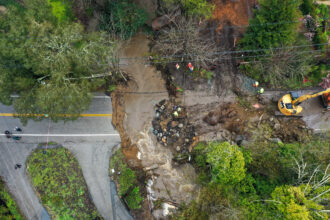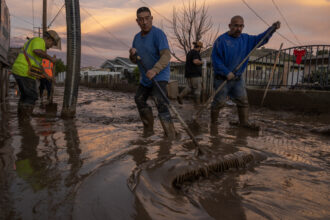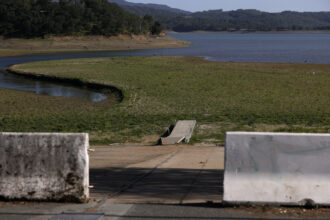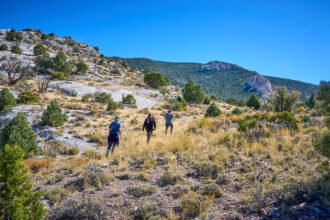In recent decades, as water has grown increasingly precious, Californians have tried countless ways to find more of it and make it last longer, including covering agricultural canals with solar panels to prevent evaporation, building costly desalination plants and pulling out tracts of water-hungry grass.
“Those low-hanging fruit have already been grabbed — that means you have to get more creative,” said Molly Bruce, a research fellow with the Wheeler Water Institute at the University of California, Berkeley School of Law.
In California’s Pajaro Valley, where floods last winter breached a levee along a river and submerged parts of a nearby town, water managers are testing out another idea: paying farmers for the amount of water they’re able to help filter back into the earth. Supporters like Bruce say it’s an idea that could help refill California’s quickly depleting groundwater supplies, at costs cheaper than many other water-saving measures.
Groundwater fills the geological pockets that sit below the earth. Pumped from the ground, this invisible water source irrigates many of the nation’s crops and provides 37 percent of the public water supply — 90 percent for people who live in rural areas. Yet despite its importance, groundwater is rarely regulated.
A recent New York Times report showed that oversight of groundwater is nearly nonexistent in most parts of the U.S. And as climate change increases the volatility of precipitation, use has outweighed supply in many areas. Many underground basins have been pushed out of balance.
“This is a big climate issue. Groundwater is an extraordinarily important source of water, but I would argue that it is abused,” said Michael Kiparsky, the Wheeler Water Institute’s founding director. “There’s little or no incentive to do either of the two things that are necessary to bring groundwater bases into balance. Those two things are: exercise restraint in pumping, and figure out a way to get more water to go into the ground when it’s available.”
Climate change has made management even more difficult. When torrential rains pass through California intensely and quickly, as they did last winter, some of that water can infiltrate underground, but not all of it. The intense rainfall can become a fast-moving run-off, rather than being directed to a place where it can easily percolate underground over time.
In certain parts of California, groundwater pumping amid drought has caused land to slowly sink and wells to run completely dry. In 2014, California passed the Sustainable Groundwater Management Act, which required local agencies to draft groundwater management plans in basins where it was already scarce. Those agencies also had to mitigate overdraft — where pumping exceeds replenishment of the aquifer — within two decades.
In the coastal and agricultural Pajaro Valley, groundwater pumping for agriculture has allowed seawater to leak into underground basins, which can make water too brackish to irrigate crops. The region created a water management agency in the 1980s, which has authority to meter wells and charge for groundwater use. Still, the region has an imbalance of about 12,000 acre feet of water per year (one acre foot is about 326,000 gallons, about half the amount that fills an Olympic-sized swimming pool).
In 2016 the region started experimenting with a program inspired by the payments that homeowners get when they install solar on their roof and sell electricity back to the grid. Instead of paying for electricity, the program pays landowners rebates for the amount of water they help flow back underground, rather than letting it run out to the ocean. Researchers examining the program, including Bruce and Kiparsky, call it “recharge net metering.”
There are several ways to percolate water back into aquifers, like flooding land and planting cover crops to help suck up more moisture and distribute it in soil. But many viable sites are located on private land. The recharge net metering program helped landowners in Pajaro Valley install a handful of “recharge basins,” which are basically empty, dirt swimming pools that catch water when it rains.
“The basic technology here is very simple,” said Kiparsky. The challenge often lies in the institutional elements of establishing, organizing and implementing these types of projects, he says. “ That’s what this is trying to solve for.”
Reiter Berry Farms was the first grower to put one of the basins on its land, a ranch that grows raspberries and strawberries. The ranch already had a “natural depression,” said Dennis Lebow, the company’s director of land and water resources, so construction mostly required creating channels in the earth to direct water from different parts of the ranch to end up there, rather than allowing it to naturally run off. Farmers get paid rebates for how much water they send back underground, which the program measures and calculates.
Reiter’s basin has weathered several years of drought and one extremely wet winter. On average, Lebow says they’ve sent about 100 acre-feet of water underground annually, which is almost as much groundwater as the ranch uses each year.
In a paper published in October, Bruce, Kiparsky and their collaborators laid out findings from the program in the Valley, which suggested that recharge net metering could be significantly cheaper per acre-foot than other water-scrimping measures. Desalination, for instance, costs $3,892 per acre-foot while recharge net metering costs $570. The team forecasts that overall, the projects installed thus far can infiltrate 375 acre-feet, enough to supply water for roughly 750 Californian homes for a year.
There’s been a lot of landowner interest in the projects, more than the team implementing it can keep up with, they say.
The payments weren’t the big draw for Reiter, Lebow says. Instead, the grower was interested in leading on projects that could help the basin balance its groundwater stores while restoring some local control. The state considers the region to be a high priority for management under the Sustainable Groundwater Management Act.
Recharge net metering is one of a handful of groundwater-focused ideas being tested in the state, in part due to the wet winter, which helped the state government prioritize finding ways to harness water when it’s available.
In September, Kiparsky started a project tied to a $2 million grant from the U.S. Environmental Protection Agency to develop guidance for managed recharge. Groundwater banking, where water is percolated underground and can then be pulled out by the same user later, has been in use in certain parts of California for decades, but new stores are being added. And some farmers in the Central Valley are letting their fields flood, allowing water to slowly sink underground.
The state has already exhausted most of the locations that would work to build new reservoirs for surface water supplies, says Ellen Hanak, a senior fellow at the Public Policy Institute of California’s Water Policy Center.
“Getting our groundwater basins into balance under the Sustainable Groundwater Management Act, that is kind of like a key to our survival as a state,” says Hanak. “We need to be able to capture water in the wet years to have it available in the dry years, and groundwater recharge is one of the best ways to do that at this point.”
For recharge net metering to work elsewhere, Lebow says the program will need some tweaks. On the Reiter ranch, maintenance costs — like clearing out accumulated sediment from the structures that direct water and help it infiltrate — at times outweighed rebates. Now, program organizers are discussing tying the payments to inflation, which has risen precipitously since the program began.
Keep Environmental Journalism Alive
ICN provides award-winning climate coverage free of charge and advertising. We rely on donations from readers like you to keep going.
Donate NowBuilding a project, by digging a basin and creating berms and other structures to direct water, can also take agricultural land out of production. Though Bruce and Kiparsky considered that economic cost in their analysis, it could still be a tough sell for a farmer.
And the Pajaro Valley had a jumpstart on program success, says Hanak — who is not involved with the program — because it already had charges in place for landowners who pumped groundwater, meaning there’s an economic incentive to balance those charges with rebates.
Nationwide, the rules governing groundwater are a patchwork. In many locations, pumping is relatively unrestricted.
That’s starting to change as supplies grow more scarce, particularly in the West. The team behind recharge net metering sees the program as a locally-driven way to expand supply. They’re now working with the Nature Conservancy to compile tools that may help other communities implement the idea. Kiparsky said he’d like to see it migrate throughout California and beyond. New ideas for water management, he said, are infrequent.
“The pace of change tends to be slow. And this is an example of what we think is a novel, incentive-based mechanism for encouraging sustainable behavior,” he said.













